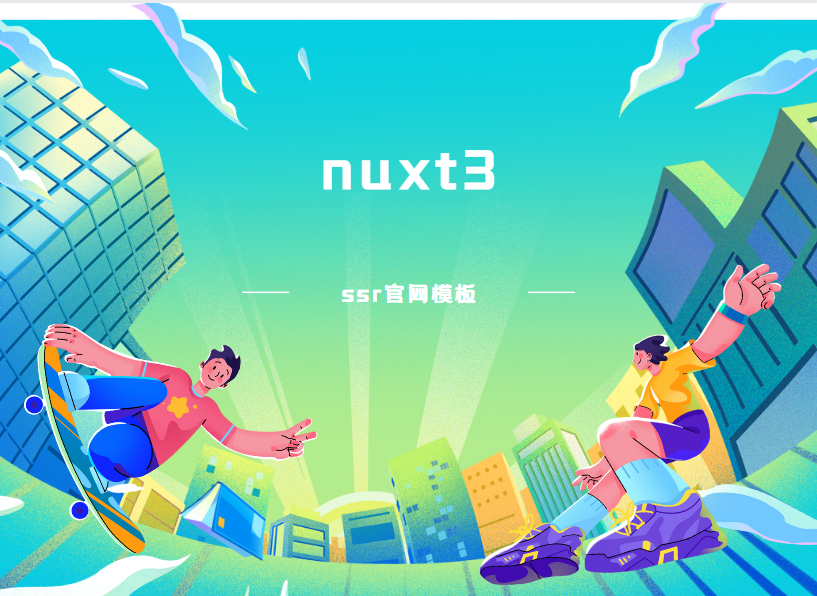
nuxt3 一套适配移动端web端 nuxt3一套代码写官网
nuxt3 一套代码适配 web端移动端
概要
产品:可能需要对我们的官网进行重构,你这边准备一下
前端: 小意思~ 不就是用css+js+html 写个静态吗。顺带把seo再优化下
产品:好的。需求文档你看下
前端:好家伙~ 一个官网pc端和移动端效果根本不一样也不是响应式能做的啊,这怎么还有ui库的功能呢
此时前端同学就开始发愁了,这得写多少代码啊。这应该怎么做。其实很早就有使用vue并且兼容seo有方案了,那就是大名鼎鼎的SSR服务端渲染。
我也是遇到了这么个需求 刚好nuxt3出来也有段时间了。打算尝尝鲜,我使用nuxt3+elmentplus 并且适配pc端移动端 css也同时支持响应式
nuxt3的中文网教程竟然是收费的,果然 有资本的地方一切东西都已丢失了他原本的意义
初始化项目
npx nuxi@latest init 你的项目名称
pnpm install 这里你使用的是什么都可以
npm run dev
目前位置就可以看到你的项目正常运行了
如果报错
Error: Failed to download template from registry: request to https://raw.githubusercontent.com/nuxt/starter/templates/templates/v3.json failed,reason: read ECONNRESET
请修改DNS为114.114,114,114 参考链接
创建页面布局
根目录创建 layouts 目录
- 创建 mobile.vue
<template>
<div>
<p>这是移动端头部</p>
<slot />
</div>
</template>
- 创建 default.vue
<template>
<div>
<p>这是默认头部</p>
<slot />
</div>
</template>
提示:这里可以根据你自己的需要改动
- app.vue
<template>
<NuxtLayout>
<NuxtPage></NuxtPage>
</NuxtLayout>
</template>
- 使用
这里实现了路由嵌套并且应用了layouts骨架默认是default。再想要使用其他页面布局的时候可以在页面这样用
<script setup>
definePageMeta({
layout: 'mobile',// 你的页面解构文件名 对应layouts文件夹中的文件名
})
</script>
web端移动端路由分发
提示:在这里pc端和移动端差距很大的时候响应式已经满足不了我们的需求。但是有很多公共组件和方法是公用的,pc端写一套 移动端写一套无疑是费力不讨好的事情。我们就采用了大名鼎鼎的m站方案, 比如下图 访问/about 路由 但他是移动端进入的 我们帮他跳转到/m/about 。所以移动端的页面相同文件名要在m文件夹中写一遍用来移动端展示

- 创建如上文件 文件里最好写点东西
- 全局中间件拦截,判断是进入移动端还是pc端页面
根目录创建middleware/auth.global.js 文件内容如下
export default defineNuxtRouteMiddleware((to, from) => {
if (process.server){ // 在服务器端处理路由
const nuxtApp = useNuxtApp()
} else { // 在客户端处理路由
// 是否是移动端设备
const isMobile = /(Android|webOS|iPhone|iPod|tablet|BlackBerry|Mobile)/i.test(navigator.userAgent)
// 是否是手机端路由
const isRouterMobile = /^\/m\//.test(to.fullPath);
// 移动端并且 不是/m开头路由
if(isMobile && !isRouterMobile){
return navigateTo(`/m${to.fullPath}`)
}
// 不是移动端 是/m开头路由
if( !isMobile && isRouterMobile){
return navigateTo(`${to.fullPath.replace('/m','')}`)
}
}
})
看不懂没关系最后有项目地址去看下就好了
引入less
既然都用了vue 肯定less 这种css处理器更方便我们使用
pnpm add less less-loader
下载好了之后页面直接使用就好

SEO处理
打开跟目录nuxt.config.ts文件 配置app选项 没有就添加一个
export default defineNuxtConfig({
devtools: { enabled: true },
app: {
head: {
charset: "utf-8",
viewport: "width=device-width,initial-scale=1",
title: "这里是页面title",
meta: [
{
name: "description",
content:"这里是网站描述",
},
{
name: "Keywords",
content:"这是是关键词",
},
],
link: [{ rel: "icon", href: "/favicon.ico", type: "image/x-icon" }],// icon
},
},
});
- 上面配置的是公共设置 如果想要在页面中设置特殊的
使用useHead可以在官网搜一下用法 会覆盖公共设置
安装element-plus
根据官方提示安装
切记配置nuxt.config.ts中的配置项
这个时候你的icon是不能用的 想要使用icon 在app.vue写如下代码
<script setup>
import * as ElementPlusIconsVue from "@element-plus/icons-vue";
// 注册图标
const nuxtApp = useNuxtApp();
for (const [key, component] of Object.entries(ElementPlusIconsVue)) {
nuxtApp.vueApp.component(key, component);
}
</script>
- 页面使用
<template>
<Title>首页</Title>
<p>我是index页面</p>
<el-button @click="ElMessage('hello')">按钮</el-button>
<ElButton :icon="ElIconEditPen" type="success">驼峰</ElButton>
<LazyElButton type="warning">懒加载按钮</LazyElButton>
<el-icon><Minus /></el-icon>
<el-steps :space="200" :active="1" finish-status="success">
<el-step title="Done" />
<el-step title="Processing" />
<el-step title="Step 3" />
</el-steps>
<div class="a">
<span class="b">13221312</span>
</div>
</template>
CSS响应式
这里使用 postcss-px-to-viewport 实现css自适应效果 vw方案 只是过渡方案既然浏览器vw支持已经很好了就使用vw方案
下载 pnpm install postcss-px-to-viewport
nuxt.config.ts中配置
import postcsspxtoviewport from 'postcss-px-to-viewport'
// https://nuxt.com/docs/api/configuration/nuxt-config
export default defineNuxtConfig({
devtools: { enabled: true },// 页面最下面的控制台
devServer: {
port: 3005,
},
app: {
head: {
charset: "utf-8",
viewport: "width=device-width,initial-scale=1",
title: "这里是页面title",
meta: [
{
name: "description",
content:"这里是网站描述",
},
{
name: "Keywords",
content:"这是是关键词",
},
],
link: [{ rel: "icon", href: "/favicon.ico", type: "image/x-icon" }],// icon
},
modules: [
'@element-plus/nuxt'
],
elementPlus: { /** Options */ },
vite:{
css: {
postcss: {
plugins: [
postcsspxtoviewport({
unitToConvert: 'px', // 要转化的单位
viewportWidth: 750, // UI设计稿的宽度
unitPrecision: 6, // 转换后的精度,即小数点位数
propList: ['*'], // 指定转换的css属性的单位,*代表全部css属性的单位都进行转换
viewportUnit: 'vw', // 指定需要转换成的视窗单位,默认vw
fontViewportUnit: 'vw', // 指定字体需要转换成的视窗单位,默认vw
selectorBlackList: ['el-'], // 指定不转换为视窗单位的类名,例如van-(vantUI组件),
minPixelValue: 1, // 默认值1,小于或等于1px则不进行转换
mediaQuery: true, // 是否在媒体查询的css代码中也进行转换,默认false
replace: true, // 是否转换后直接更换属性值
exclude: [/node_modules/], // 设置忽略文件,用正则做目录名匹配,最好不要排除node_modules 文件,排除后在项目中会发现字体不能跟随页面放大
landscape: false // 是否处理横屏情况
})
]
}
}
}
});
这个时候就可以自由自在使用我们的pc直接在页面中疯狂撸码了
这个时候页面中直接写750px 就是100%了。 如果出现滚动条 关闭默认样式margin padding
有心的小伙伴可能就注意了到了 那我一个750的我的pc端怎么办呢,我们其实可以在蓝湖上自定义设计稿宽度 将pc的设计稿和修改为750就可以了
如果使用flexible是在页面执行了一段js脚本。给html设置了font-size但运行js脚本是需要时间的。可能会出现页面特别大突然变小的情况。所以请慎用!!
使用PM2部署
- 服务器安装PM2 这我就不细讲了。网上搜一下
- 打包项目 npm run build
- 拿到打包后的产物 根目录.output文件夹
- .output根目录创建ecosystem.config.js
module.exports = {
apps: [
{
name: 'NuxtAppName', // 设置启动项目名称
port: '3005',// 端口
exec_mode: 'cluster',//应用程序的执行模式。可以是 cluster(多进程模式)或 fork(单进程模式)
instances: 'max', //在 cluster 模式下,应用程序运行的实例数量。max 表示根据可用 CPU 核心数创建尽可能多的实例。
script: './server/index.mjs',//应用程序的脚本路径。这是启动应用程序的主要入口
}
]
}
- .output放到服务器 运行项目 pm2 start ecosystem.config.js
- 设置服务器重启 项目自动启动 pm2 startup
总结
- 项目地址
- 部署的话可以看官网的PM2部署 也可以自己搜 。这里讲的pm2可能有点糙了
- 不理解的小伙伴可以私信我 也可添加我v互相交流
H1274714546
优化 针对m站路由跳转出现警告问题
删除 middleware/auth.global.js
public下创建isMobile.js 内容如下
(function () {
// 获取当前协议(http: 或 https:)
const currentProtocol = window.location.protocol;
// 获取当前主机(包括主机名和端口号)
const currentHost = window.location.host;
// 获取当前路径(包括斜杠)
const currentPath = window.location.pathname;
// 是否是移动端设备
const isMobile = /(Android|webOS|iPhone|iPod|tablet|BlackBerry|Mobile)/i.test(
navigator.userAgent
);
// 是否是手机端路由
const isRouterMobile = /^\/m\//.test(currentPath);
// 移动端并且 不是/m开头路由
if (isMobile && !isRouterMobile) {
window.location.replace(
`${currentProtocol}//${currentHost}/m${currentPath}`
);
}
// 不是移动端 是/m开头路由
if (!isMobile && isRouterMobile) {
window.location.replace(
`${currentProtocol}//${currentHost}${currentPath.replace("/m", "")}`
); //跳转后没有后退功能
}
})();
nuxt.config.ts 中 app>head中配置下即可
script: [{ src: “/isMobile.js” }],

开放原子开发者工作坊旨在鼓励更多人参与开源活动,与志同道合的开发者们相互交流开发经验、分享开发心得、获取前沿技术趋势。工作坊有多种形式的开发者活动,如meetup、训练营等,主打技术交流,干货满满,真诚地邀请各位开发者共同参与!
更多推荐
 已为社区贡献1条内容
已为社区贡献1条内容





所有评论(0)